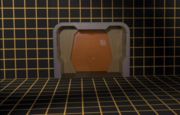Difference between revisions of "Holodeck"
(→Design) |
(→Design) |
||
| Line 7: | Line 7: | ||
Inside the holodeck, a virtual environment is created via holograms made tangible through the use of force fields. In order to simulate outdoor areas, landscapes can be projected on the walls<ref>TNG "Encounter at Farpoint"</ref>. Through optical illusions, the holodeck can support multiple users, each seeing a different part of the simulation.<ref>TNG "Elementary, Dear Data"</ref> | Inside the holodeck, a virtual environment is created via holograms made tangible through the use of force fields. In order to simulate outdoor areas, landscapes can be projected on the walls<ref>TNG "Encounter at Farpoint"</ref>. Through optical illusions, the holodeck can support multiple users, each seeing a different part of the simulation.<ref>TNG "Elementary, Dear Data"</ref> | ||
Holodecks are equipped with safety settings to prevent the injury or death of their users. Without these safeties, the holodeck is as dangerous as whatever environment it simulates.<ref>''[[Star Trek: First Contact]]''</ref> Deactivating the safeties can theoretically be done only by authorized personnel<ref>TNG "Descent"</ref>; in practice, if any kind of malfunction occurs in a holodeck's hardware or software, the safeties will almost certainly fail.<ref>TNG "The Big Goodbye", "A Fist Full of Datas", "Emergence", etc.</ref> | Holodecks are equipped with safety settings to prevent the injury or death of their users. Without these safeties, the holodeck is as dangerous as whatever environment it simulates.<ref>''[[Star Trek: First Contact]]''</ref> Deactivating the safeties can theoretically be done only by authorized personnel<ref>TNG "Descent"</ref>; in practice, if any kind of malfunction occurs in a holodeck's hardware or software, the safeties will almost certainly fail.<ref>TNG "The Big Goodbye", "A Fist Full of Datas", "Emergence", DS9 "Our Man Bashir", etc.</ref> | ||
==Usage== | ==Usage== | ||
Revision as of 21:30, 25 August 2009
The holodeck (or holosuite) is a technology in the Star Trek universe which allows the user to create a life-like virtual environment through the use of holograms. It can be used for training[1] or research[2], but has primarily achieved popularity as a form of entertainment.
Design
When not in operation, a holodeck looks like an empty chamber. Holographic emitters and force field generators are embedded in the walls and one or more control surfaces are usually available, either as a stand-alone console or as a wall panel. The holodeck generally has only one exit.[3]
Inside the holodeck, a virtual environment is created via holograms made tangible through the use of force fields. In order to simulate outdoor areas, landscapes can be projected on the walls[4]. Through optical illusions, the holodeck can support multiple users, each seeing a different part of the simulation.[5]
Holodecks are equipped with safety settings to prevent the injury or death of their users. Without these safeties, the holodeck is as dangerous as whatever environment it simulates.[6] Deactivating the safeties can theoretically be done only by authorized personnel[7]; in practice, if any kind of malfunction occurs in a holodeck's hardware or software, the safeties will almost certainly fail.[8]
Usage
Most holodecks carry a library of pre-programmed simulations.[9] Additionally, programs are available commercially, either for sale[10] or for rent, from Ferengi traders or other market-driven societies. Users can also create their own holodeck programs by giving the computer voice commands describing the environment to simulate.
After selecting or defining a program, the user enters the simulation. The program generally ends when one or more objectives have been completed.[11] The user can save and restore his or her progress at any time, reset the simulation, or alter its contents.[12]
At any time the user can call for a control console (or "arch") to manipulate the simulation or access the holodeck's exit door.[13]
It is possible for the user to create his or her own holoprogram. This can be done by using existing sensor or library computer data[14], via voice commands[15] or through written text.[16]
Risks and incidents
While holodecks are a widely-used technology, and commercial holodecks have a respectable safety record, the holodecks in use on Federation starships have shown a significant amount of unexpected behaviour and outright malfunctions. The holodeck safeties in particular are prone to failure;[17] and even with the safeties working, it is possible to receive injuries on the holodeck.[18] Additionally, it is often difficult or impossible to evacuate users from a malfunctioning holodeck, and simply turning off the simulation with people inside can be dangerous to the occupants.[19]
In two peculiar incidents, the holodeck accidentally created a fully sapient artificial intelligence.[20]
See Also
References
- ↑ DS9 "The Magnificent Ferengi"
- ↑ TNG "Identity Crisis"
- ↑ TNG "The Big Goodbye"
- ↑ TNG "Encounter at Farpoint"
- ↑ TNG "Elementary, Dear Data"
- ↑ Star Trek: First Contact
- ↑ TNG "Descent"
- ↑ TNG "The Big Goodbye", "A Fist Full of Datas", "Emergence", DS9 "Our Man Bashir", etc.
- ↑ Star Trek: First Contact
- ↑ DS9 "Our Man Bashir"
- ↑ DS9 "Our Man Bashir"
- ↑ TNG "The Big Goodbye"
- ↑ Star Trek: Generations
- ↑ TNG "Ship in a Bottle"
- ↑ TNG "Schisms"
- ↑ VOY "Author, Author"
- ↑ TNG "The Big Goodbye", "A Fist Full of Datas"
- ↑ TNG "Conundrum" - a crew member injured her shoulder in a diving simulation
- ↑ TNG "The Big Goodbye"
- ↑ TNG "Elementary, Dear Data", VOY "Spirit Folk"
